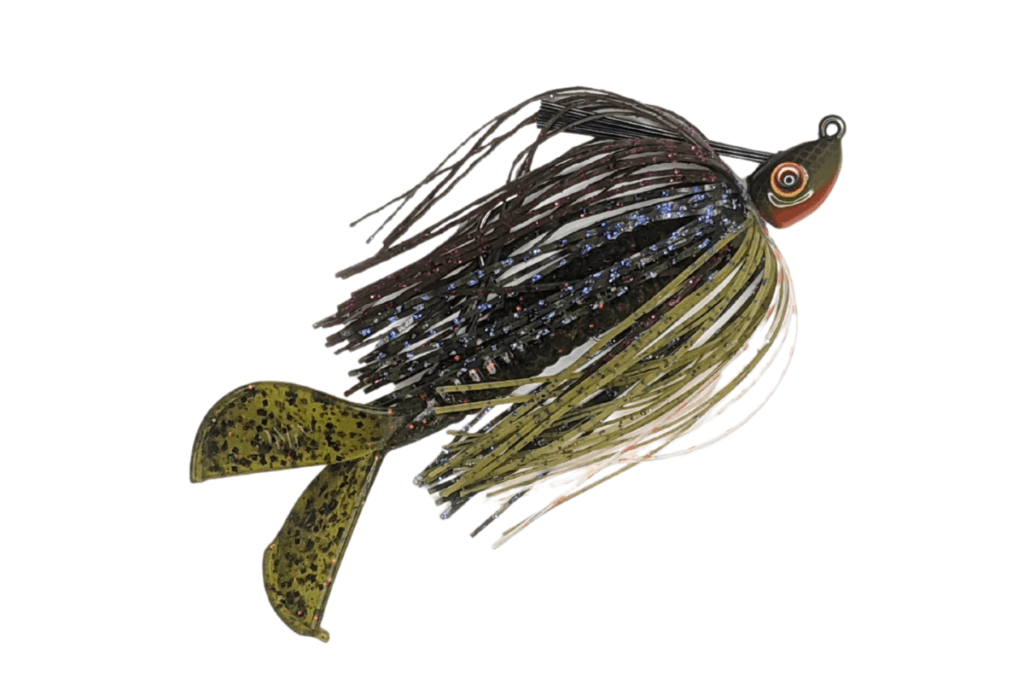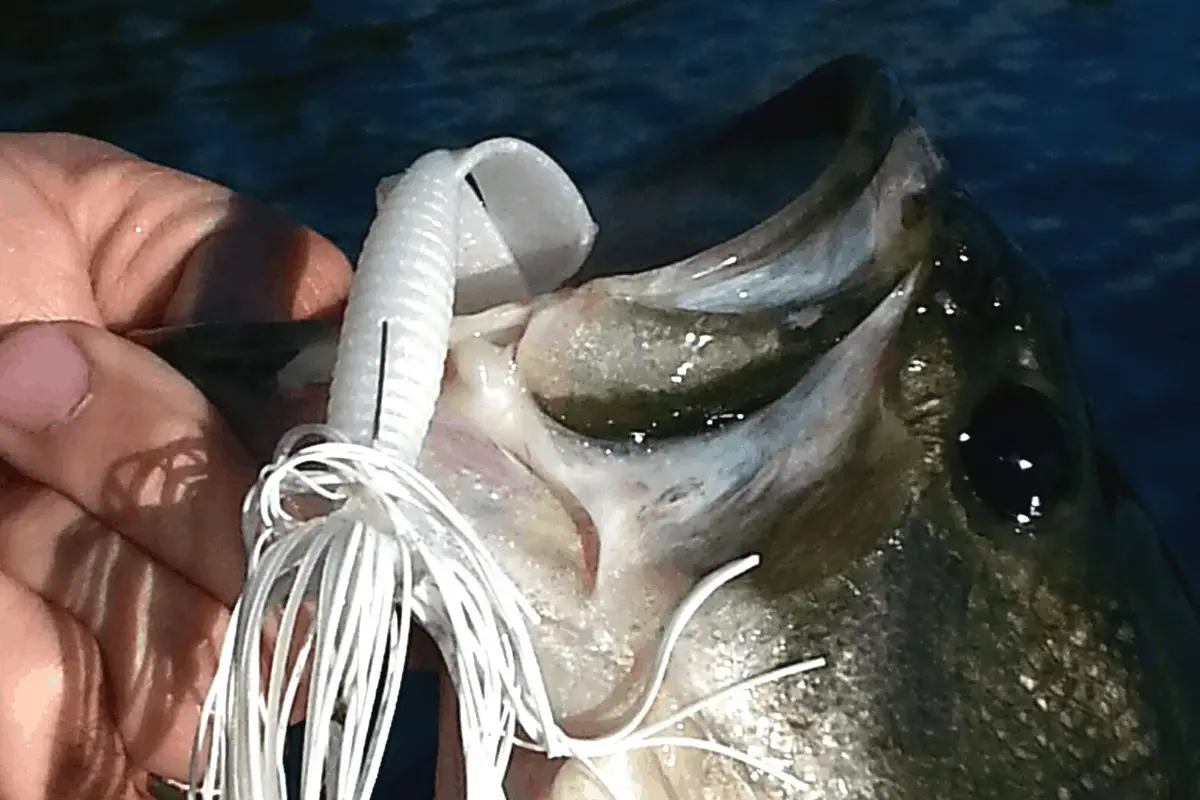A swim jig is one of the most versatile lures out there. It can be used in a wide range of seasons and conditions. It is also one of the few baits where consistent, arm-ripping strikes are commonplace.
To fish a swim jig effectively, make sure it is moving as slow as possible without sinking in the water column. The lure should mimic a wounded baitfish that is struggling to stay afloat. It is ideal for coming through all sorts of thick cover where big bass live.
I love, and I mean love, fishing a swim jig. On most lakes throughout the country, this is my go-to lure no matter what the weather is doing. I have had so much success with it and it presents an easy meal that bass have a difficult time resisting. The swim jig is also a lure that has a small learning curve. New anglers can experience success with it their first day on the water.
For some reason, this lure is also one that time-and-time-again offers up strikes that are so savage the rod just buckles in your hand. That feeling never gets old.
In this article, I will break down the specifics of using a swim jig and how you too can feel more strikes that nearly yank the rod right from your grip.

The Lure
While a swim jig definitely falls under the “jig” family, it is designed differently than a traditional flipping jig.
The head has a slender profile that cuts through the water column when fished horizontally. That head design also allows the jig to slither its way through grass and vegetation with ease. The more sleek design gives an angler the ability the fish the lure slowly while maintaining position in the water column.
If you want to get some more “pulse” and “life” out of the lure, I suggest trimming the skirt. Pull the strands down until they lay flat. Take a pair of scissors and cut the skirt material just below the bend of the hook. When the lure is in the water the strands will now flare out and appear more life-like.
The Soft Plastic Trailer for Swim Jigs
There are many different soft plastic trailers that can be used behind the head of the jig. I prefer to use a twin tail grub, specifically the Rage Menace. The resistance this trailer creates in the water column allows it to be fished as slow as possible while keeping its horizontal position coming back to the angler.
Other popular plastic trailers for swim jigs include single tail grubs and paddle tail swimbaits.
The soft plastic trailer is a critical component to swim jig success. In most cases, I will choose a color for the trailer that matches the jig itself. As with most lures, match the color to the forage base in the water that you are fishing. My home lake has zero shad, but is teaming with bluegills. My swim jig and trailers are selected to best match that primary forage base. If your home water has a population of shad – then whites, silvers, and grays are excellent color patterns to start with.
The Equipment to Fish a Swim Jig
To get the best results when using a swim jig, equipment needs to be matched accordingly.
The Rod
The swim jig is one of those crossover lures that finds itself in a niche between a traditional jig and a lure that is presented strictly in a horizontal manner. To manage the possibility of ripping some bass out of thick vegetation and still maintaining a softer tip, I like to use a medium-heavy power rated rod with a fast action.
The particular model I use is 7’ 3”. This length is perfect for my height, provides plenty of power when making long casts, and is easy to use when roll casting into tight cover.
The Reel
For most horizontal presentations, I prefer a low gear ratio reel. When fishing a swim jig, I make an exception. My reel of choice is a high speed gear ratio model that is my traditional selection when using a lure like this.
There are plenty of times when a bass inhales that swim jig in the middle of a gnarly pile of vegetation. The quicker Recovery Per Turn allows me to winch that hefty fish out of the cover before it gets buried up too deep.
The Line
If the water has some stain or is dirty, I will fish straight 50lb braid. In ultra clear water, I will either spool up with all fluorocarbon or use a fluoro leader attached to the braid.
Monofilament also works fine when fishing a swim jig, especially if you are looking to keep the lure higher in the water column.
The Most Effective Swim Jig Presentations
There are three different presentations that I use when swim jig fishing. Each of them works well, so I suggest trying each of them out for yourself and find what fits your fishing style.
Presentation #1
This is my favorite. I learned this particular retrieval method from the swim jig guru – Tom Monsoor.
Tom is from LaCrosse, WI and has fished a swim jig for decades. He has carved out a successful career on the FLW Tour and offers that a swim jig has been a large part of his success.
He uses this phrase, “Float like a butterfly, sting like a bee.”
Sound familiar?
Tom says this to himself as he retrieves the swim jig. It helps him to keep the lure moving as slow as possible, yet still maintain its position in the water column. As I mentioned earlier, the goal is to make a bass think that there is a prey fish of some sort that is having a difficult time staying afloat. This easy meal is often more than a bass can stand and that wiley predator will annihilate it.
Keep the rod tip up and pulse it from the 10 o’clock to 11 o’clock position. Reel up the slack line as you go and keep saying that phrase. Visualise a struggling baitfish and you will be well on your way to some great days on the water.
Presentation #2
The second way in which I fish a swim jig is with what I call the straight swim. This is the method that I employ when I want to fish a little deeper, but with the same jig that I have tied on.
Cast the lure out and let it settle to the bottom. Give the rod a slight pulse to get the trailer going and then reel it back nice and steady. Keep the rod tip low for maximum depth. A good plastic trailer will be working away.
I will either let the lure bounce into everything I can with this retrieve, or more likely, I will try to fish it right where the light penetration stops in the water column. In other words, let the lure sink down and fish it back just out of sight.
In clear water, this may be in the 12’ – 15’ range. I have found that probing this zone right where bass can stay hidden in the darker part of the water column, is a great way to catch some real big fish.
Using a trailer with excellent action is the key component to having success with this second presentation style.
Presentation #3
The last presentation is credited to Randy Howell, a long-time tournament pro who calls Lake Guntersville his home.
Randy holds the rod in the 11 o’clock position and pulses it, quickly, all the way back to the boat. You want to give the lure many, many, quick little pops on the retrieve. The lure under the water will really be dancing and drawing quite the attention.
To fish this presentation technique effectively, you must have braided line. Mono and fluoro will work, but there is zero stretch in braid, therefore you are imparting the most action directly to the lure.
This method keeps the lure in the upper part of the water column and can be efficiently fished over a variety of different cover.
It is the most exhausting of the three until you build up some endurance with your wrist.
Final Thoughts
A swim jig is an amazing fish finding and catching tool. I have one tied on all the time and it is usually my first choice when investigating a new body of water.
To get the most out of the lure, set your baitcaster as loose as possible to gain maximum distance on your casts. The swim jig is so good at getting fish to reveal themselves you will want to cover a lot of water with it.
I hope that you have great success with this lure. Let me know how it goes for you and send some photos of those big bass.
Tight lines. Be safe, and don’t forget to go out and encourage someone today, you never know what a difference you may make in their life!

